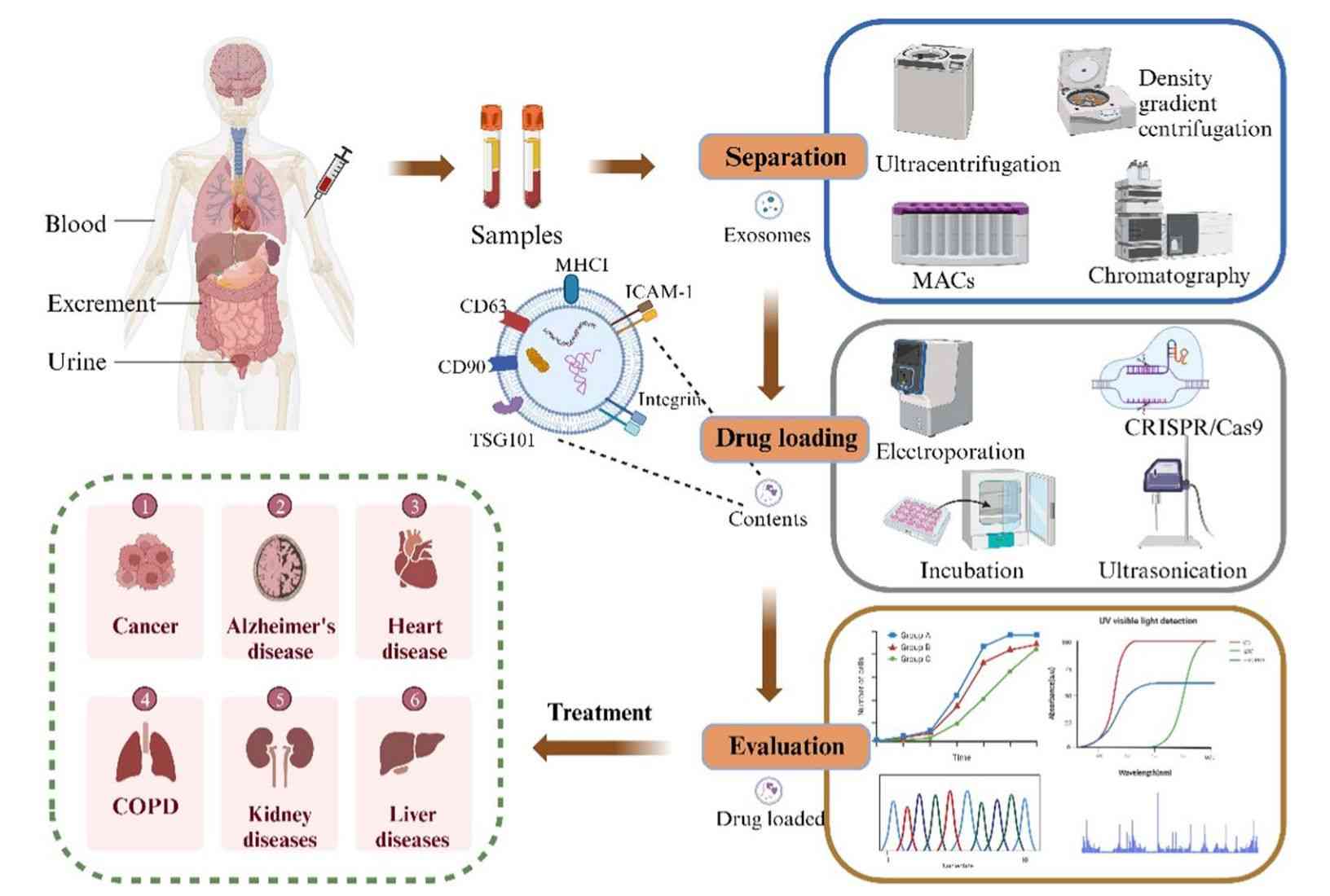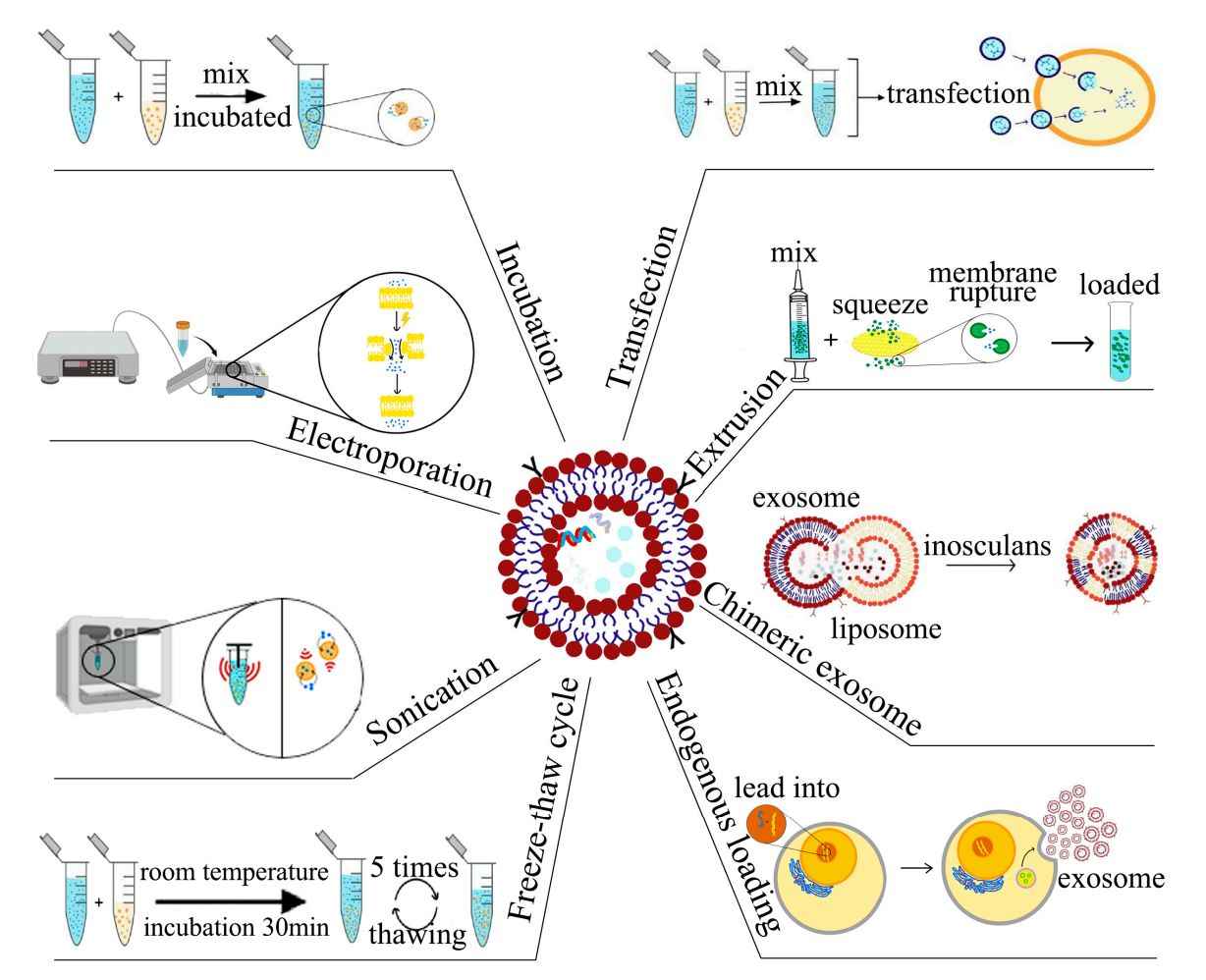How do Exosomes Load Drugs?
Exosomes are emerging as drug carriers with higher stability and biocompatibility. The challenge for the final application in clinical therapy is how to effectively load drugs into exosomes.
 Figure 1. Overview of the process for engineering exosomes for therapeutic applications. (Chen Z, et al., 2024)
Figure 1. Overview of the process for engineering exosomes for therapeutic applications. (Chen Z, et al., 2024)
Why Choose Exosomes as Drug Delivery Carriers?
The type of carrier is essential to achieve drug or gene delivery. Exosomes combine the benefits of cellular drug delivery and nanotechnology. Compared to cell-based therapies, exosomes are easier to store and have low safety risks. It is possible to isolate exosomes from patient body fluids or cell cultures, modify and transfer them back to the patient.
Advantages of exosomes for drug delivery:
- Exosomes exhibit greater stability in blood and are capable of long-distance delivery in vivo under physiologic and pathologic conditions.
- Exosomes have a hydrophilic core suitable for accommodating soluble drugs.
- Exosomes are nanosized, carry cell surface molecules, and can overcome various biological barriers.
- Exosomes have natural targeting capabilities.
- Exosomes have extremely low immunogenicity.
Exosome Drug Loading Strategies
Exosomes are a naturally occurring cellular secretion, how can they be made to carry specific drug molecules? Currently, exosome drug-carrying strategies can be divided into two categories: Endogenous and Exogenous. As the name suggests, endogenous loading refers to the loading of cargo molecules in the exosome-producing cell, while exogenous loading refers to the isolation and purification of the exosome before completing the loading process.
 Figure 2. Strategies for exosome drug loading. (Zeng H, et al., 2023)
Figure 2. Strategies for exosome drug loading. (Zeng H, et al., 2023)
Endogenous loading/preloading is an engineered loading method based on donor cells. Drugs are loaded into donor cells before the isolation of exosomes, thereby encapsulating them into exosomes during the natural biogenesis of the drug. This method modifies the donor cells to produce the target exosome by co-incubating the cells with the cargo or transfecting the cells with the target gene. Preloading allows the continuous production of exosomes loaded with cargo without disrupting membrane integrity. However, its loading efficiency is low and the amount of cargo cannot be controlled.
- Exogenous loading
| Methods | Description | Advantages | Limitations |
| Sonication | Sonication utilizes high-frequency sound waves to load drugs into exosomes. The mechanical energy of the sound waves creates transient pores or openings in the exosome membrane that encapsulate the therapeutic agent. | Simple and direct loading of multiple drugs, both small and large molecules. | A high-energy sonication process may cause damage or destruction of exosomes. |
| Electroporation | Electroporation utilizes brief, high-voltage electrical pulses to create temporary pores in the exosome membrane for encapsulation of a variety of therapeutic agents, including nucleic acids such as siRNAs and mRNAs. The electrical pulses are carefully calibrated to not compromise the structural integrity of the exosome. | A highly efficient drug-carrying method can encapsulate a wide range of therapeutic agent types, gentler on exosomes compared to sonication. | Optimization of parameters (e.g., voltage, pulse duration) is essential to maintain exosome integrity. |
| Extrusion | Extrusion is a gentle method of exosome drug delivery. The exosome is passed through a series of polycarbonate membranes with defined pore sizes and the therapeutic agent is doped inside the exosome. This method is suitable for loading hydrophilic drugs. | The gentle method minimizes damage to the exosome. | Less efficient drug loading compared to other techniques. Requires multiple extrusion steps and can be time-consuming. |
| Incubation | Incubation refers to the process of allowing drug molecules to come into full contact with exosomes under certain conditions, relying on the hydrophobicity of the exosome membrane to passively complete the loading process. | Simple operation, will not damage the integrity of the exosome membrane. | Mainly applicable to hydrophobic small molecules, loading of hydrophilic molecules is less efficient and takes a longer time. |
| Dialysis | Hypo-osmotic dialysis (HP) allows the loading of drugs into exosomes. A mixture of exosomes and drug is placed on a dialysis membrane or in dialysis tubing and then dialyzed with agitation to obtain drug-loaded exosomes. | Increased efficiency compared to passive incubation. | Cellular uptake of drug-carrying exosomes produced by HP may be reduced and HP may induce protein degradation. |
| In situ Assembly and Synthesis | In situ synthesis is a non-invasive strategy for loading nanomaterials onto the surface of exosomes or within exosomes. | Maintains the integrity of the exosome. | Complex procedures and technical barriers. |
Selection of Appropriate Drug Delivery Methods
| Molecule Type | Drug Loading Method |
| siRNA | Electroporation, chemical transfection, sonication, cell overexpression. |
| miRNA | Chemical transfection, cell overexpression, fusion expression, electroporation, PH gradient. |
| mRNA | Cell overexpression, electroporation, fusion expression, nano puncture. |
| DNA | Transfection of donor cells, electroporation. |
| Protein | Electroporation, chemical transfection, extrusion, sonication, cell overexpression, EV marker protein fusion expression, protein-protein interaction. |
| Lipids | Cyclic freezing and thawing, co-incubation. |
| Small molecule | Co-incubation, electroporation, sonication, chemical transfection, extrusion, hypo-osmotic dialysis, cyclic freezing and thawing. |
Creative Biostructure is a leading biological company specializing in one-stop exosome services. Utilizing our cutting-edge technology, we provide efficient exosome drug delivery solutions that ensure precise and effective encapsulation of therapeutic agents. Our expertise supports a wide range of applications, helping clients achieve innovative drug delivery strategies and breakthrough research advances in exosome-based therapeutics. Please feel free to contact us for more details.
References
- Chen Z, et al. Encapsulation and assessment of therapeutic cargo in engineered exosomes: a systematic review. J Nanobiotechnology. 2024. 22(1): 18.
- Zeng H, et al. Current Strategies for Exosome Cargo Loading and Targeting Delivery. Cells. 2023. 12(10): 1416.
- Huang L, et al. Research Advances of Engineered Exosomes as Drug Delivery Carrier. ACS Omega. 2023. 8(46): 43374-43387.